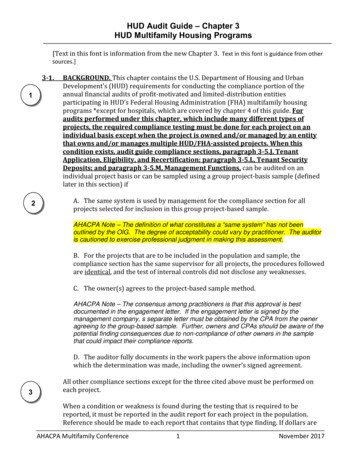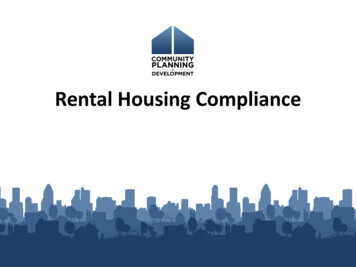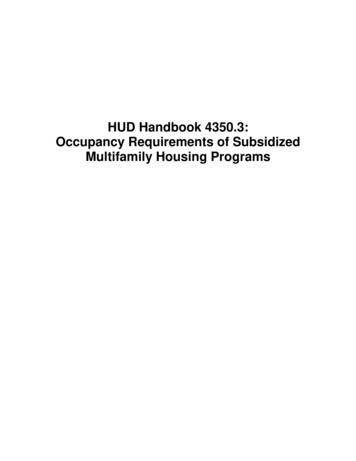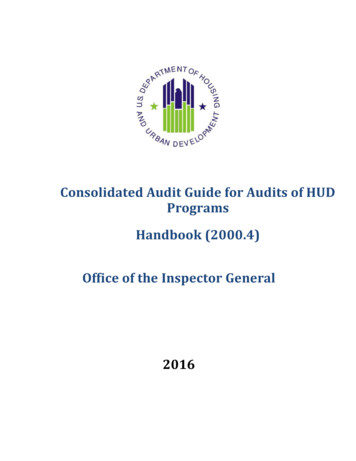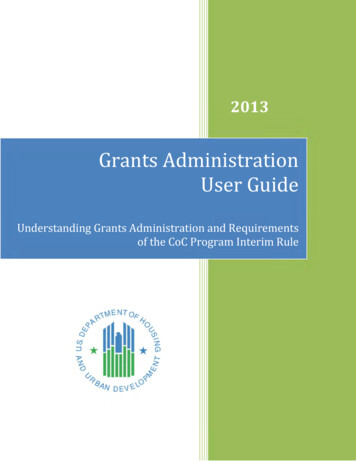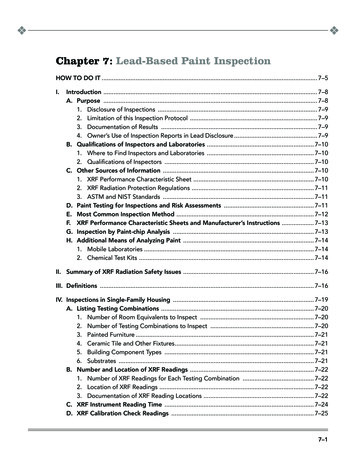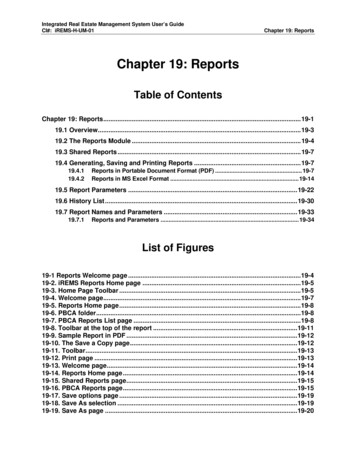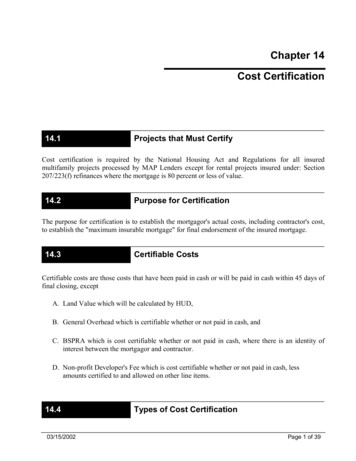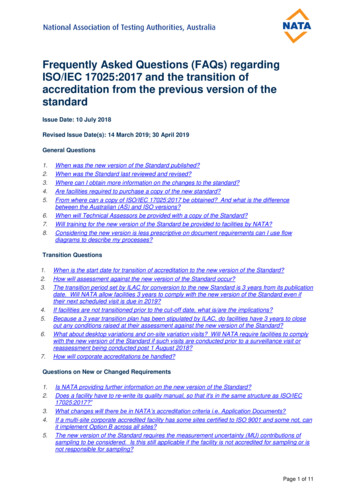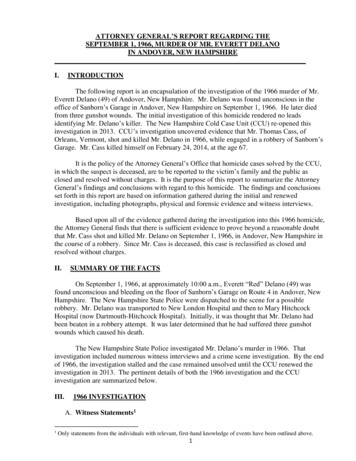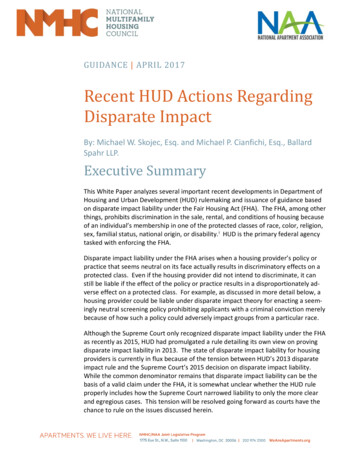
Transcription
GUIDANCE APRIL 2017Recent HUD Actions RegardingDisparate ImpactBy: Michael W. Skojec, Esq. and Michael P. Cianfichi, Esq., BallardSpahr LLP.Executive SummaryThis White Paper analyzes several important recent developments in Department ofHousing and Urban Development (HUD) rulemaking and issuance of guidance basedon disparate impact liability under the Fair Housing Act (FHA). The FHA, among otherthings, prohibits discrimination in the sale, rental, and conditions of housing becauseof an individual’s membership in one of the protected classes of race, color, religion,sex, familial status, national origin, or disability. i HUD is the primary federal agencytasked with enforcing the FHA.Disparate impact liability under the FHA arises when a housing provider’s policy orpractice that seems neutral on its face actually results in discriminatory effects on aprotected class. Even if the housing provider did not intend to discriminate, it canstill be liable if the effect of the policy or practice results in a disproportionately adverse effect on a protected class. For example, as discussed in more detail below, ahousing provider could be liable under disparate impact theory for enacting a seemingly neutral screening policy prohibiting applicants with a criminal conviction merelybecause of how such a policy could adversely impact groups from a particular race.Although the Supreme Court only recognized disparate impact liability under the FHAas recently as 2015, HUD had promulgated a rule detailing its own view on provingdisparate impact liability in 2013. The state of disparate impact liability for housingproviders is currently in flux because of the tension between HUD’s 2013 disparateimpact rule and the Supreme Court’s 2015 decision on disparate impact liability.While the common denominator remains that disparate impact liability can be thebasis of a valid claim under the FHA, it is somewhat unclear whether the HUD ruleproperly includes how the Supreme Court narrowed liability to only the more clearand egregious cases. This tension will be resolved going forward as courts have thechance to rule on the issues discussed herein.
2General BackgroundHUD Rule on Disparate ImpactOn February 15, 2013, HUD issued a final rule promulgating the standard for disparate impact liability under the FHA. 2 HUD issued this rule at a time when eleven federal courts of appeal agreed that the FHA encompassed discriminatory effects (disparate impact) liability despite the statute not providing a standard for such liability.The Supreme Court, at this time, had not yet formally recognized disparate impact liability. Because of the lack of Supreme Court and statutory guidance, HUD suggestedit issue the rule to create a uniform standard.The rule formally established a three-part burden shifting test for determining whena housing practice has a discriminatory effect even without discriminatory intent.The regulation states that a practice has a discriminatory effect “where it actually orpredictably results in a disparate impact on a group of persons or creates, increases,reinforces, or perpetuates segregated housing patterns because of race, color, religion, sex, handicap, familial status, or national origin.” 3First, the plaintiff must demonstrate that the challenged practice caused or predictably will cause a discriminatory effect. 4 Then, the burden shifts to the defendant toprove that the challenged practice is necessary to achieve one or more “substantial,legitimate, nondiscriminatory interests.” 5 If the defendant satisfies that burden,then, the plaintiff must prove that the substantial, legitimate, nondiscriminatory interest could be accomplished through a practice that has a less discriminatory effect.6The defendant will be able to prevail if it can show that the substantial, legitimate,nondiscriminatory interest cannot be achieved through a practice that has any lessdiscriminatory effect. 7Although the Supreme Court soon after issued its own standard for proving disparateimpact liability under the FHA, HUD usually cites to this rule as the standard in theHUD guidance and rules that are discussed herein.Supreme Court Decision on Disparate Impact LiabilityThe Supreme Court formally recognized disparate impact liability as a cognizableclaim under the FHA in its 2015 opinion Texas Dept. of Housing v. Inclusive Communities Project (ICP). 8 The Court noted that, unlike a discriminatory intent case wherethe plaintiff has to establish that the defendant had a discriminatory motive, disparate impact cases involve a defendants’ practice that has a disproportionately adverseeffect on minorities. 9Under the standard announced by the Court in ICP, a plaintiff must prove discriminatory effects using statistical evidence to demonstrate that the practice causes a racialBACKGROUNDER APRIL 2017RECENT HUD ACTIONS REGARDING DISPARATE IMPACT
3disparity. There must be a strong causal connection between the housing provider’schallenged practice and the discriminatory effect. 10 This “robust causality requirement,” the Court said, “protects defendants from being held liable for racial disparities they did not create.” 11 Despite recognizing disparate impact liability, the Courtnoted that the bar is relatively high for plaintiffs because “private policies are notcontrary to the disparate-impact requirement unless they are ‘artificial, arbitrary, andunnecessary barriers” to fair housing. 12Legal commentators are in disagreement about how much the Supreme Court’s holding in ICP limited disparate impact liability. Some of the HUD-issued guidance discussed herein, such as the criminal screening guidance and insurer non-exemptions,is currently the issue of federal court litigation as to whether it is consistent with theSupreme Court disparate impact standards as opposed to the HUD-issued rule on disparate impact liability. 13 The eventual decisions in these court cases will shed lighton whether federal courts think that HUD exceeded its authority in what some viewas HUD’s recent over-zealous issuance of rules and guidance in the last days of a departing Administration.HUD POST-ICP RULINGAfter the Supreme Court’s 2015 ruling in ICP that most commentators viewed as narrowing disparate impact liability, HUD remained firm in progressively attempting tobroaden the doctrine by using its own rule. HUD’s activity has mainly taken the formof issuing informal guidance or promulgating formal regulations. Agencies issue guidance to explain their understanding of a statute, not to create substantive law. Onthe contrary, when an agency issues formal regulations as part of the notice and comment rulemaking process, the regulations do carry the force of law. Courts thereforedo not have to accept conclusions reached in agency guidance, but are instead ableto provide the guidance the proportionate amount of deference that the court feels itdeserves, based on factors such as its legal persuasiveness, thoroughness, validity ofits reasoning, and consistency with prior agency pronouncements.14HUD Supplement Statement: Application of FHA’s Discriminatory Effects Standard to InsuranceAlthough only indirectly affecting housing providers, HUD’s issuance of supplementalpublic comments in October 2016 regarding the application of the FHA to the insurance industry is an example of HUD pushing back on any narrowing of disparate impact liability in the wake of the ICP opinion. 15In 2011, after HUD released the proposed rule on the three-stage burden shifting approach to disparate impact liability, several insurance trade associations submittedBACKGROUNDER APRIL 2017RECENT HUD ACTIONS REGARDING DISPARATE IMPACT
4comments to the proposed rule that criticized the application of disparate impact liability to insurers and requested a categorical exemption for all insurance underwriting practices. 16Claims against insurance companies for disparate impact in the sale or refusal to sellinsurance for housing properties were regularly being made. When HUD issued thefinal rule in 2013, it denied the categorical exemption request and instead stated thatHUD would adjudicate insurance company concerns on a case-by-case basis. 17 Underthe rule, an insurer could face disparate impact liability for using certain risk factors inunderwriting that had a discriminatory effect on protected classes. A federal court in2014 later held that HUD acted arbitrarily and capriciously in failing to adequately explain why case-by-case adjudication was preferable to a categorical exemption.18In response to the federal court mandate to better explain its reasoning, and in theaftermath of the ICP decision recognizing disparate impact claims under the FHA,HUD released the October 2016 supplemental statement. HUD’s eight-page statement provided two overarching reasons for why it would not create the safe harborexemptions sought by the insurance industry. First, it claimed it would be "practicallyimpossible" to define the scope of the exemptions with sufficient precision given thediversity of potential discriminatory effects claims. 19 Second, HUD balanced that theexemptions sought would undermine the remedial purpose and effectiveness of theFHA in a way that outweighed any of the insurer concerns.20In response to insurance association criticisms that disparate impact liability couldthreaten the actuarial standards underpinning the insurance market, HUD reassuredinsurance providers that “practices that an insurer can prove are risk-based, and forwhich no less discriminatory alternative exists, will not give rise to discriminatory effects liability.” 21Although this rule does not directly affect private housing providers, it does demonstrate HUD’s recent efforts to expand disparate impact liability despite the ICP decision. The court challenges to these HUD efforts will continue.HUD Guidance: Application of FHA Standards on Criminal RecordsA second example of HUD’s proactive efforts to increase the use of disparate impactand expand potential liability is in its recent criminal screening policy guidance, whichapplies to all housing providers. 22 The guidance imposes disparate impact liability forcriminal screening policies that disproportionately affect a protected class absent alegitimate, nondiscriminatory reason.23The guidance admits that the FHA does not contemplate a protected class for individuals with a criminal conviction. 24 HUD reiterates, however, that disparate impact liability exists anytime a policy has the effect of disproportionately burdening a particu-BACKGROUNDER APRIL 2017RECENT HUD ACTIONS REGARDING DISPARATE IMPACT
5lar race without justification. 25 HUD points to national statistics demonstrating African Americans and Hispanics are incarcerated at a rate disproportionate to theirshare of the general population. 26 HUD then concludes that criminal convictionscreening policies consequently violate the FHA, because of their relation to race, ifthey lack a legally sufficient justification.27HUD states that intentional discrimination liability can arise from criminal screeningpolicies as well. Housing providers cannot intentionally treat two comparable applicants differently because of their race. 28 For example, it would violate the FHA todeny an African American solely based on a particular prior crime yet admit an Asianapplicant guilty of that same exact crime.HUD uses reasoning similar to its linking of incarceration to race to expand FHA protections to other types of individuals in its recent guidance. As will be further discussed below, HUD argues that disparate impact liability also protects persons withlimited ability to speak English because of their close relationship to the protectedclass of national origin.HUD also argues for disparate impact protections to victims of domestic violence because of their close relationship with the protected class of gender. With such an expansive interpretation of disparate impact liability, and the ease at which nationaldata is available and breadth at which it is collected, it is easy to see how HUD, if itchose to, could continue to issue guidance expanding protections to more groups ofpeople traditionally not protected by the FHA.Although it remains to be seen how the criminal screening guidance will be enforcedby the new Administration, if at all, it does not significantly alter the screening policies currently employed by many housing providers, provided that those policies already are proportionately tailored to weight certain types of convictions to meet legitimate safety and property interests in a non-arbitrary way.HUD Final Rule on Affirmatively Furthering Fair HousingOn July 16, 2015, just a month after the Supreme Court’s ICP decision, HUD finalizedits new regulation on affirmatively furthering fair housing. HUD’s stated purpose forenacting the regulation is to provide HUD program participants with an effectivestrategy to further the FHA’s goals of overcoming historic patterns of segregation,promoting fair housing choice, and fostering inclusive communities that are free fromdiscrimination.29 This rule does not apply to all housing providers, just those participating in certain HUD programs.The FHA, in addition to prohibiting discrimination in housing, imposes a requirementthat HUD administer its programs in a manner that affirmatively furthers fair housing. 30 Before the new rule, HUD achieved this goal by requiring program participants(which includes states, local governments, and public housing agencies) to completeBACKGROUNDER APRIL 2017RECENT HUD ACTIONS REGARDING DISPARATE IMPACT
6an “analysis of impediments” that identified impediments to fair housing in their jurisdiction and make corresponding plans and actions to remedy those impediments. 31However, HUD found that these reports were generally either not submitted to HUD,or when they were, they were not reviewed by HUD. 32 Participants lacked clear guidance from HUD on how to grapple with fair housing issues of race or disability in making grant decisions.33HUD through its new rule therefore replaced the impediments analysis system with astandardized Assessment of Fair Housing (AFH) through which participants will identify and evaluate their fair housing issues and in turn reviewed by HUD.34 HUD willprovide more data on fair housing issues to participants so that they can better prioritize and set goals.35Unlike before, HUD anticipates actually reviewing the strategic plans and assessmentsof program participants.36 HUD will not set specific outcomes and it will continue toallow decision making to occur at the local and regional levels. 37 HUD’s goal is thatby increasing the tools and data with which program participants have to address fairhousing issues, the participants will be empowered to foster diversity and overcomesegregation in furtherance of the FHA’s mission. 38Although this rule has little effect on private housing providers, it is another exampleof HUD’s increasingly proactive role over the past year in expanding its authority tomeasure racial population and possible historic segregation in previously unseenways. The new Administration and Congress will likely revisit these efforts soon. 39HUD’S MOST RECENT RULES ANDGUIDANCEWithin the past year, and particularly since September 2016, HUD has become increasing active in issuing guidance and final rules relating to disparate impact liabilityunder the FHA. This is the main subject and purpose of this White Paper. The following section outlines the notable developments and provide best practices recommended for avoiding liability under these recent enactments.HUD Rule on Quid Pro Quo/Hostile Environment HarassmentLiabilityThe following are the best practices recommended for avoiding liability under HUD’sRule prohibiting quid pro quo and hostile environment harassment: BACKGROUNDER APRIL 2017Train staff to understand and recognize quid pro quo and sexual environmentharassment by both other staff or by residents and the appropriate processfor addressing itRECENT HUD ACTIONS REGARDING DISPARATE IMPACT
7 Develop a grievance mechanism so that individuals who feel victimized byquid pro quo or hostile environment harassment can bring their complaint tomanagement for proper resolutionOn September 16, 2016, HUD issued a final rule that prohibits “quid pro quo” harassment and “hostile environment harassment” because of an individual’s membershipin a protected class. 40 The rule took effect on October 14, 2016. HUD’s purpose increating the rule was to establish consistent standards for housing providers to followto ensure that their properties were free of unlawful conduct.HUD additionally sought to provide clarity to victims so that they could better assesspotential FHA claims. HUD additionally set forth standards for when housing providers could be held vicariously or directly liable for unlawful harassment or discrimination either by them or by third parties.HUD justified the need for formal regulations on hostile environment harassment inthe housing context because it found that courts often applied Title VII employmentlegal standards when reviewing harassment claims under the FHA, which althoughsimilar, contained differences in certain aspects.The regulations define hostile environment harassment as “unwelcome conduct thatis sufficiently severe or pervasive as to interfere with” the terms, conditions, or privileges of rental of a dwelling. 41 The rule creates a totality of the circumstances test fordetermining whether hostile environment harassment exists, which balances factorssuch as the severity, scope, frequency, duration, and location of the conduct, as wellas the relationships between the persons involved. 42The victim need not demonstrate that psychological or physical harm to show thatharassment occurred. Whether the harassment is “sufficiently severe or pervasive”as to create liability for the housing provider is judged based on the standard of a“reasonable person” in the victim’s position.The rule also prohibits “quid pro quo” harassment, which is Latin for “this for that.”Quid pro quo harassment occurs when a person is subjected to an “unwelcome request or demand to engage in conduct where submission to the request or demand,either explicitly or implicitly, is made a condition related to” the availability, terms, orconditions of rental of a dwelling.” 43 Such quid pro quo harassment can come by email, text messages, social media, taunting or teasing, or threatening statements.Quid pro quo harassment can occur even if the victim complies in the request.The most concerning aspect of the new regulations for housing providers is how therule imposes liability on housing providers for the conduct of a third party. The rulecreates three categories of direct liability for housing providers—liability for the housing provider's own conduct; liability for failing to take prompt corrective action relating to the conduct of its employees or agents; and liability for failing to take promptcorrective action for the conduct of a third party (such as another resident). 44 The ef-BACKGROUNDER APRIL 2017RECENT HUD ACTIONS REGARDING DISPARATE IMPACT
8fect of this third category is that a housing provider can be liable for one tenant’s discriminatory conduct against another tenant if the housing provider “knew or shouldhave known of the discriminatory conduct and had the power to correct it.” 45Whether a housing provider has the power to correct the discriminatory conduct of athird party depends on the extent of the housing providers control and legal responsibility over that person.46 This becomes a question of the language in the leaseagreement and property rules and the provisions of state and local law. The ruledoes not define what steps a housing provider must take in remedying the discriminatory conduct.Although the breadth of potential liability under this regulation should concern housing providers, it appears
Claims against insurance companies for disparate impact in the sale or refusal to sell insurance for housing properties were regularly being made. When HUD issued the final rule in 2013, it denied the categorical exemption request and instead stated that HUD would adjudicate ins
